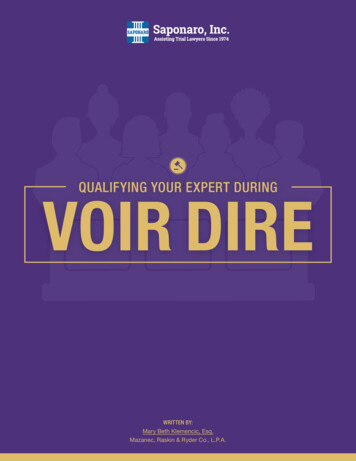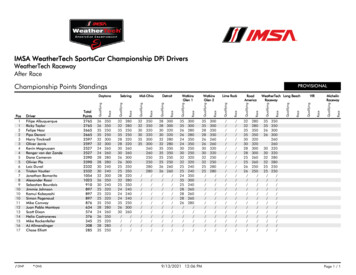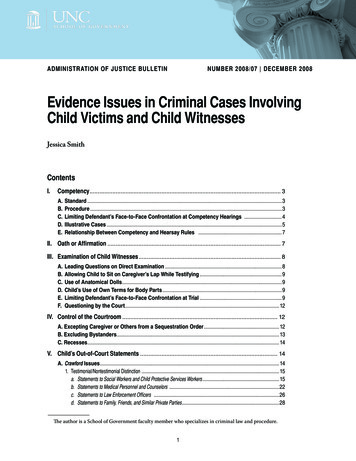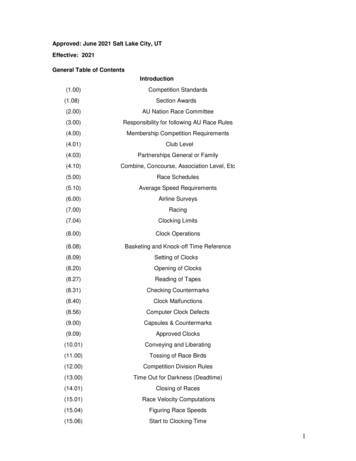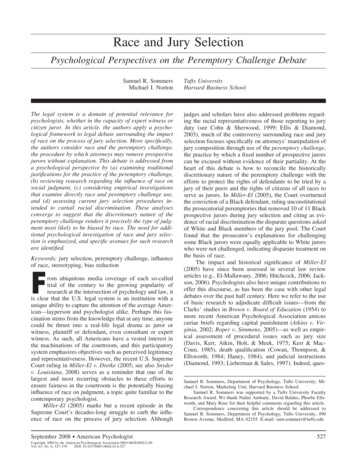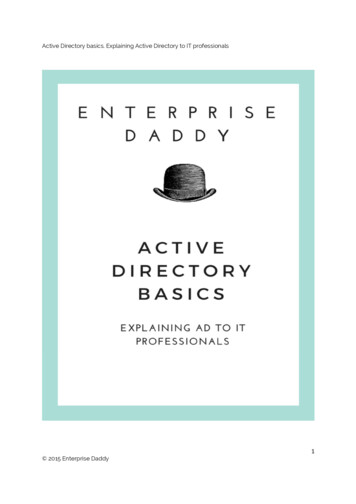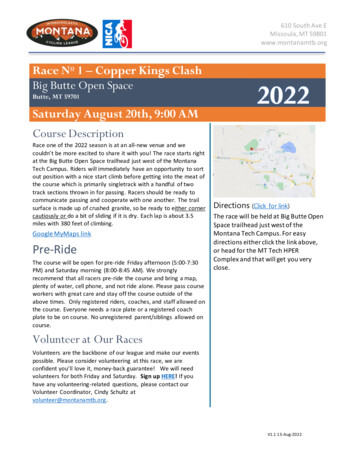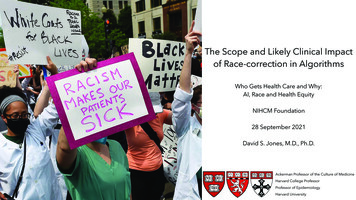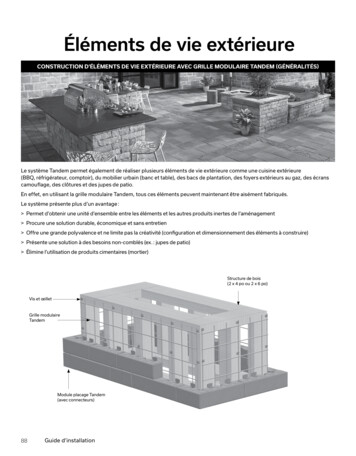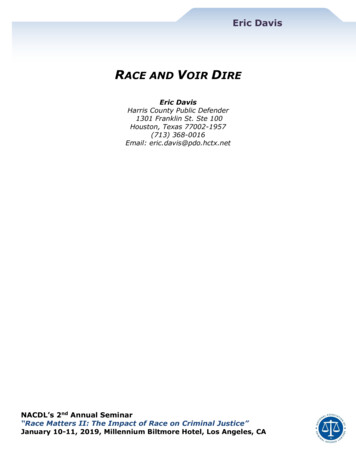
Transcription
Eric DavisRACE AND VOIR DIREEric DavisHarris County Public Defender1301 Franklin St. Ste 100Houston, Texas 77002-1957(713) 368-0016Email: eric.davis@pdo.hctx.netNACDL’s 2nd Annual Seminar“Race Matters II: The Impact of Race on Criminal Justice”January 10-11, 2019, Millennium Biltmore Hotel, Los Angeles, CA
RACE MATTERS IIThe Impact of Race on Criminal JusticeRace and Voir DireRace is an issue in Jury Selection in nearly every trial inAmerica and wealth isn't an issue. The following is an excerpt concerning Bill Cosby’strial.After multiple blackswho indicated that theycould be fair were struckby the prosecution, BillCosby was convicted bya mostly white jury.“Brian J. McMonagle, one ofMr. Cosby’s lawyers, saidthat the woman was being excluded for racial reasons, noting that prosecutors had rejected a black female sales coordinator a day earlier. “Webelieve this is a systematic exclusion of African-Americans who answered that theycould be objective,” Mr. McMonagle said. Mr. Cosby cameto Pittsburgh, he added, “hoping he could find a favorable,diverse jury.”“We believe it is paramount that there be a diverse juryand we believe that we cannot get a diverse jury,” he said.Eric J. DavisChief of the Felony Trial DivisionHarris County Public Defender’s OfficeHouston, Texas
ERIC J. DAVISEric J. Davis has been a practicing attorney since 1994 and accepted employment at the HarrisCounty Public Defender’s Office in September of 2011. There Mr. Davis serves as the Chief ofthe Felony Trial Division. Immediately prior to joining the Public Defender’s Office, Mr. Daviswas the senior member of Davis & Associates, PLLC, a law firm based in Houston, Texas. Mr.Davis graduated from Howard University with honors in 1991 and from Tulane University LawSchool with honors in 1994. He is also a graduate of Gerry Spence’s Trial Lawyer’s Collegewhere he honed his trial skills by learning from some of the best trial lawyers in the country.Following graduation, Mr. Davis was asked to join the staff of the college. He currently serveson the staff of the Trial Lawyers College and helps train lawyers from across the country. In2016, he received the Mentor of the Year Award from the Harris County Criminal LawyersAssociation for his efforts mentoring and training lawyers.Mr. Davis started his legal career as a prosecutor in Florida. While serving as a prosecutor, Mr.Davis was selected (based on trial skill) to serve in a sex crimes unit where lawyers focused onprosecuting all types of sexual assault cases. This experience and training helped Mr. Davisdevelop experience in handling these types of cases. As a criminal defense attorney, he hassuccessfully represented people accused of sex crimes, some in high-profile cases, and hasobtained dismissals and "not guilty" verdicts. He has successfully defended numerous criminalcases in Federal and State Court. He has obtained “not guilty” verdicts and dismissals in alltypes of cases and in numerous different counties. Mr. Davis has tried over 100 cases to verdict.He has tried all types of federal and state court cases ranging from Capital Murder, to multipledefendant drug conspiracies, to misdemeanors. Moreover, Mr. Davis has defended federalcriminal cases in every federal district in the State of Texas and in federal district courts inFlorida, Louisiana, and Illinois.In 2003, Mr. Davis received a commendation from the Texas State Legislature for his serviceas Special Counsel to the Texas State Commission on Judicial Conduct. For the Commission,Mr. Davis was lead counsel in a case that removed a judge from office who was mistreatingcitizens by wrongfully jailing them and addressing them in an abusive manner in court.Handling the case from beginning to end, Mr. Davis was able to obtain an order that the Judge beremoved from office and that he never be allowed to hold judicial office again. The case waswidely featured in several television news programs and newspaper articles.In 2006, Mr. Davis received the “Unsung Hero Award" from the Harris County CriminalLawyers Association. In that same year, he received the "Man of the Year Award" from theHouston Business and Professional Women's Association. Also that same year, Mr. Davis madenational news and was featured in several stories printed in the Houston Chronicle for his workthat exonerated a man who had been wrongfully imprisoned for over 18 years for an allegedsexual assault of a child. Although the government reported that there were no samples to test
for DNA in the case, Mr. Davis pressed forward and found the DNA that freed his client. Afterthe client was pardoned, Mr. Davis secured financial compensation for him in excess of 450,000.00. The case was covered by local and national news outlets.Although Mr. Davis has successfully defended many criminal cases, most notable is thesuccessful defense of a double homicide in 2007 where the prosecutor boasted prior to trial thatthere was no way his client could win. With the client's approval, Mr. Davis rejected theprosecutor’s 40 year plea deal, fought the case at trial, obtained a "not guilty" verdict and securedthe client's freedom. Additionally, Mr. Davis’ has been able to secure "not guilty" verdicts anddismissals in other murder cases as well. In 2010, prosecutors were disciplined for improperlystriking all African- Americans from a jury panel in a murder case defended by Mr. Davis andTexas Southern University Law School Graduate, Jacquelyn R. Carpenter. The case made thefront page of the Houston Chronicle and was reported on several television and radio newsstations. Mr. Davis and Ms. Carpenter subsequently tried the case again to another all-white juryand obtained a “not guilty” verdict. Another client defended by Mr. Davis who had a CapitalMurder case dismissed was featured in an article in the New York Times.In 2011, the same year Mr. Davis joined the Public Defender’s Office, Mr. Davis completed hissecond, successive successful representation of a client charged in a Federal Medicare FraudConspiracy trial by securing multiple “Not Guilty” verdicts on behalf of a doctor charged. Hisclients were acquitted of all of the federal charges. Both victories were in cases againstprosecutors from the Federal Medicare Fraud Task Force that pulled prosecutors from around thecountry to try those cases. That Federal Task Force rarely lost cases. And following those cases,a Task Force Prosecutor surprisingly told Mr. Davis that Task Force Prosecutors privatelyreferred to him as “Taskforce Kryptonite.”Mr. Davis also has experience handling appeals and post-conviction writs in both Federal andState Courts. In 2008, Mr. Davis, arguing before the United States Fifth Circuit Court ofAppeals, obtained the reversal of a life sentence and conviction which was imposed by a FederalDistrict Court in a drug conspiracy case. In 2009, Mr. Davis argued before the Thirteenth Courtof Appeals in Texas and obtained the reversal of a 75 year sentence and conviction. The courtordered a new trial for the client.As the Chief of the Felony Trial Division, Mr. Davis coordinates the Division’s in-house trainingprogram and coordinates over 25 hours of CLE training for the local defense bar every year. In2019, Mr. Davis will serve on the Planning Committee for the Texas Advanced Criminal LawCourse which is the primary source of CLE to Judges, Prosecutors and Defense Lawyersthroughout the State of Texas.Additional details regarding Mr. Davis' education, admissions, and affiliations with professionalassociations follow.
EducationTulane University Law School, Juris Doctorate: May 1994, cum laudeHoward University, Bachelor of Arts: May 1991, magna cum laudeLicensure and AdmissionsThe United States Supreme Court, admitted 2003The United States Court of Appeals for the Fifth Circuit, admitted 2001The United States District Court, Southern District of Texas, admitted 2000The United States District Court, Western District of Texas, admitted 2002The United States District Court, Eastern District of Texas, admitted 2002The United States District Court, Northern District of Texas, admitted 2002The United States District Court of Colorado, admitted 2007The United States District Court, Central District of Illinois, admitted 2007The State Bar of Texas, licensed 1997The Florida Bar, licensed 1994Professional AssociationsState Bar of TexasNational Bar AssociationThe Texas Bar Foundation, FellowHarris County Criminal Lawyers’ AssociationNational Criminal Defense Lawyers’ AssociationTexas Criminal Defense Lawyers’ AssociationAlumni Association of the Trial Lawyers CollegePublished Judicial OpinionsUnited States v. Harris, 566 F.3d 422 (5th Cir. 2009).In re Thurman Bill Bartie, 138 S.W.3d 81 (Tex. App. Austin 2004).Joshua Reynolds v. State of Texas, 371 S.W.3d 511 (Tex. App. Houston [1st Dist] 2012).Seminars and PresentationsStaff, Trial Lawyers College, Actively teaching all trial skills at the Trial Lawyers College inWyoming and at regional seminars, 2006- present.
The Texas Criminal Defense Lawyers Association CLE- Sexual Assault: Gladiators in Suits,Cross-Examination of Child Witness: Et Tu, Brute?, December 6-7, 2018, Fort Worth, Texas.The Texas Criminal Defense Lawyers Association CLE- Phones, Forensics & Snitches, Oh My! ,Handling Priors- the Big One, the Little One, and all the Others, September 13-14, 2018,Lakeway, Texas. (Tied for Top Rated Speaker at the entire CLE).Criminal Law Clinic Boot Camp, Thurgood Marshall School of Law, Brady v. Maryland and39.14, August 13, 2018, Houston, Texas.National Association of Criminal Defense Lawyers CLE, Defending Idaho: AdvancedAdvocacy and Trial Skills Course, Effective Voir Dire, August 9, 2018, Boise, Idaho.National Association of Criminal Defense Lawyers CLE, Defending Idaho: AdvancedAdvocacy and Trial Skills Course, Cognitive Biases and Their Impact on the Criminal JusticeSystem, August 8, 2018, Boise, Idaho.National Association of Criminal Defense Lawyers CLE, Defending Idaho: AdvancedAdvocacy and Trial Skills Course, Cross Examining Emotional and Difficult Witnesses, August9, 2018, Boise, Idaho.National Association of Criminal Defense Lawyers CLE –Murder, Mayhem and Malice inMiami, Murder?!?. It’s Self-Defense, July 26-28, 2018, Miami, Florida.Advanced Criminal Law Course 2018, Texas State Bar, Punishment in Sexual Assault Cases,July 23, 2018, San Antonio, Texas (Also served as a Co-Moderator, inviting and coordinatingspeakers, for the Sexual Assault Break-out Session).Faculty, Wisconsin State Public Defender Trial Skills Academy 2018, Voir Dire Lecture, May12-18, 2018, Fontana, Wisconsin.National Association of Criminal Defense Lawyers CLE Advanced Skills in Sexual AssaultDefense Training, Cross- Examining Difficult Witnesses, March 8-9, 2018, Indianapolis, Indiana.National Association of Criminal Defense Lawyers CLE Advanced Skills in Sexual AssaultDefense Training, Voir Dire in Sexual Assault Cases, March 8-9, 2018, Indianapolis, Indiana.The Texas Criminal Defense Lawyers Association CLE- To Kill a Sex Crime, Punishment: Howto Get as Few Licks as Possible, December 7-8, 2017, Austin, Texas. (Tied for Top RatedSpeaker at the entire CLE).2017 Annual Criminal Defense Conference of the Wisconsin State Public Defender’s Office,Voir Dire to Win Your Case, November 17, 2017, Milwaukee, Wisconsin.2017 Annual Criminal Defense Conference of the Wisconsin State Public Defender’s Office,Using and Cross Examining Experts, November 17, 2017, Milwaukee, Wisconsin.
Advanced Criminal Law Course 2017, Texas State Bar, Punishment in Sexual Assault Cases,July 18, 2017, Houston, Texas.National Association of Criminal Defense Lawyers CLE – The Voodoo of Voir Dire, It’s NotJust Lagniappe, It’s Voir Dire on Self-Defense, March 1-4, 2017, New Orleans, Louisiana. (TopRated Speaker at the entire CLE).The Texas Criminal Defense Lawyers Association Voir Dire – Outside The (Jury) Box CLE,Jury Selection on Defenses, September 8-9, 2016, Dallas, Texas. (Rated amongst the Top 5speakers at the entire CLE).Faith and Law Around the Globe, Integrity as Defense Counsel, April 21-26, 2016, EntabeniSafari Conservancy, South Africa.Harris County Criminal Lawyers Association CLE on Maneuvering Search & Seizure Law,Ethics in Contesting Searches, March 4, 2016, Houston, Texas. (Top Rated Speaker at theentire CLE).National Association of Criminal Defense Lawyers CLE -The Science of the Mind: LitigatingMental Health in Criminal Cases, Voir Dire in Mental Health Cases, February 17-20, 2016,Austin, Texas.The Texas Criminal Defense Lawyers Association Nuts N’ Bolts and Morton Act CLE,Mitigation and Punishment Hearings, January 7, 2016, Lubbock, Texas. (Rated amongst theTop 5 speakers at the CLE).The Texas Criminal Defense Lawyers Association 28th Annual Rusty Duncan AdvancedCriminal Law Course, Mitigation and Punishment, June 18-20, 2015, San Antonio, Texas.(Rated amongst the Top 5 speakers at the CLE).The Texas Criminal Defense Lawyers Association Voir Dire CLE -A Taste of Voir Dire, VoirDire: Self-Defense and Other Defenses, March 5-6, 2015, Houston, Texas. (Top Rated Speakerat the Entire CLE).Public Defender’s Office CLE on Criminal Appointments in Harris County, Impeachment—aNuts and Bolts Demonstration, October 9-10, 2014, Houston, Texas. (Rated amongst the Top 5speakers at the CLE).Criminal Law Clinic Boot Camp, Thurgood Marshall School of Law, Michael Morton Act: Whatdoes it mean in terms of practice? And, 38.23? What is it and how to get the Judge to give it toyou?, August 16-17, 2014, Houston, Texas.Advanced Criminal Law Course 2014, Texas State Bar, Mitigation and Punishment, Making theBest Out of a Bad Situation, July 21-24, 2014, Houston, Texas.
The Texas Criminal Defense Lawyers Association Federal Law Seminar, Presentation and Paperon Ethics in Federal Court, March 6, 2014, Houston, Texas. (Rated amongst the Top 5 speakersat the CLE).Friendship Community Bible Church, Men’s Health & Criminal Justice Awareness Day, PanelDiscussion, December 14, 2013, Sugarland, Texas.The Harris County Institute of Forensic Science’s Expert Witness Testimony Workshop & MockTrial, Demonstrated Cross Examination of Experts – Medical Examiner and Ballistics Expert,November 7-8, 2013, Houston, Texas.The Texas Criminal Defense Lawyers Association Cross Examination CLE, Presentation andPaper, Impeaching the State’s Witnesses in a Criminal Trial, March 7, 2013, Dallas, Texas.(Rated amongst the Top 5 speakers at the CLE).American Bar Association, National Taskforce on Stand Your Ground Laws, SouthwestRegional Hearing, Testimony Regarding the Impact of Stand Your Ground Laws on the CriminalJustice System, February 8, 2013, Dallas, Texas.The First Annual Hon. Craig Washington & Senator Rodney Ellis Criminal Law Seminar,Presentation and Paper on Cross Examination, February 2012, Houston, Texas.Round-Table Discussion on Stand Your Ground Laws at South Texas College of Law, 2012,Houston, Texas.Staff, Texas Criminal Defense Lawyers Association, CLE on Voir Dire, 2011, Roundtop, Texas.
Race and Voir DireIn December of 2018 in Houston, Texas, two good trial lawyers were trying acase where self-defense was an issue. The case involved a Black man who wasaccused of killing a White man. It was the third time in three years they tried thecase. The first jury which consisted of blacks, whites and Hispanics was hung 10to 2 in favor of acquittal. The second jury which also consisted of blacks, whitesand Hispanics was hung 11 to 1 in favor of acquittal. This third trial, with a new setof prosecutors and no black people on the jury, saw a verdict of guilty on the chargeof murder. The jury deliberated under three hours before returning a verdict. Whythe difference in results? Race.Prosecutors know they have a distinct advantage when trying a blackdefendant to an all-white jury. As such, jury selection and the use of peremptorychallenges is wrought with the danger of racial manipulation. A recent study of trialsin Caddo Parish, Louisiana, revealed that potential jurors who were black were muchmore likely to be struck from juries than non-blacks. In Caddo Parish, an area knownfor its many death sentences, prosecutors used peremptory strikes against 46% ofblack jurors, but only 15% of other jurors, according to a study by ReprieveAustralia.1 That study showed evidence of systematic discrimination in the juryselection process that appeared virtually unchecked. The results were consistentwith findings from Alabama, North Carolina, and other parts of Louisiana.1U. Noye, "Blackstrikes: A Study of the Racially Disparate Use of Peremptory Challenges bythe Caddo Parish District Attorney’s office," (Reprieve Australia, August, 2015).
In an Alabama study, prosecutors used peremptory strikes to remove 82% ofeligible black potential jurors from trials in which the death penalty was imposed. Astudy of death penalty cases in North Carolina found that prosecutors struck 53% ofblack potential jurors but only 26% of others.2The racial composition of the juries in Caddo Parrish appeared to make adifference in the ultimate outcome of the cases. The study found that no defendantswere acquitted by juries with 2 or fewer black jurors, but 19% were acquitted when5 or more jurors were black.3Given that the prosecutor’s chances of winning go up with nondiverse juries,it is easy to see why prosecutors take this short cut. The availability of this short cutthrough peremptory challenges, makes the threat of discrimination during juryselection more real. In Batson v. Kentucky, legendary U.S. Supreme Court JusticeThurgood Marshall noted that “[t]he inherent potential of peremptory challenges todistort the jury process by permitting the exclusion of jurors on racial grounds shouldideally lead the Court to ban them entirely from the criminal justice system.”4 JusticeDeath Penalty Information Center, Studies: Racial Bias in Jury Id. It should be noted that Louisiana, unlike most other states, does not require unanimousverdicts. 10 out of 12 jurors voting in unison is all that is needed to return a verdict.24Batson v. Kentucky, 476 U.S. 79, 107(1986).
Marshall thought the danger was so great that banning peremptory challenges fromthe process was the only way to safeguard defendants from discrimination.Although the U.S. Supreme Court has yet to take a position as strong as JusticeMarshall’s, it has reversed multiple cases where peremptory challenges wereexercised in a discriminatory manner. In fact, in recent years, the Supreme Courthas taken an aggressive stand and has rendered multiple favorable decisions onBatson issues. Thus, Batson challenges are still a viable tool that lawyers can use tocombat discrimination in the jury selection process. This paper will discuss properlymaking a Batson Challenge and the law surrounding it. And given that race appearsto make a difference in the jury selection process, this paper will discuss methods ofconducting voir dire on race.Batson ChallengesUnlike challenges for cause, which are normally based on logical reasons whypotential jurors are biased, prejudiced, or unqualified to serve in a particular case;peremptory challenges are often inspired by hunches, improper considerations,intuition, or “shots in the dark.”5 And as advocates, lawyers use peremptorychallenges not to select an impartial jury, but to select a jury that will be partial totheir client’s cases. This happening simultaneously on both opposing sides furtherhampers the process. In 1997, two law professors affiliated with Pepperdine LawSchool identified five main problems surrounding the use of peremptory challenges.6They assert:First, attorneys who exercise peremptory challenges aim to select a jurythat is biased in favor of their client. This motive hinders, rather thanadvances, the guarantee of a trial by an impartial jury. Second, theexercise of peremptory challenges is largely based on the attorney’sbiases and prejudices toward persons of a particular race, religion,gender, age, educational background, socioeconomic status, and otherassociations. Such exercise has led to discrimination against classes ofpotential jurors, which may profoundly affect both parties’ ability toobtain a trial by an impartial jury. Although the U.S. Supreme CourtSee MICHAEL J. SAKS & REID HASTIE, SOCIAL PSYCHOLOGY IN COURT 55 (1978).See Carol A. Chase & Colleen P. Graffy, A Challenge for Cause Against PeremptoryChallenges in Criminal Proceedings, Loyola of Los Angeles International and Comparative LawJournal (1997).56
has issued rulings in the past decade to curb the use of peremptorychallenges as an instrument of racial or gender discrimination, thoserulings have not had their anticipated effect. The third main problemwith peremptory challenges is that their availability has led to extensiveand intrusive voir dire examination of potential jurors, and thus,increased the duration of jury trials. Fourth, the use of challenges hasraised the cost of jury trials due to the use of expensive jury “experts”who assist attorneys in identifying jurors most likely to favor one sideor the other. Finally, the mere existence of peremptory challengespermits the courts to avoid deciding whether a juror is truly biased orprejudiced because the attorney may still exercise a peremptorychallenge if the judge denies a challenge for cause.7Making Batson ChallengesBatson v. Kentucky provides a three-step process for adjudicating claims ofdiscriminatory use of peremptory challenges. “First, a defendant must make a primafacie showing that a preemptory challenge has been exercised on the basis of race;second, if that showing has been made, the prosecution must offer a race-neutralbasis for striking the juror in question; and third, in light of the parties’ submissions,the trial court must determine whether the defendant has shown purposefuldiscrimination.”8 The third step turns on factual findings made by the lower courts.Prima Facie CaseEstablishing a prima facie case of purposeful discrimination, involves firstidentifying that a stricken juror is a member of a protected cognizable group. Then,the party raising the challenge needs to show that this fact, along with any otherrelevant circumstances, creates an inference that the opposing party has used aperemptory challenge – or multiple challenges – to strike potential jurors on the basisof their membership in that group. Such a prima facie case can be made by offeringa wide variety of evidence, so long as the totality of the facts gives rise to theinference of discriminatory purpose. One common method of doing so isarticulating a comparative analysis of the panel demonstrating there was a patternof striking a disproportionate number of members of the cognizable protectedgroup.9 For example, in Dewberry v. State, 776 S.W.2d 589 (Tex. Crim. App. 1989),Id.Snyder v. Louisiana, 552 U. S. 472, 477 (2008) (internal quotation marks and brackets omitted).9Miller L v. Cockrell, 537 U.S. 322, 331 (2003).78
the prosecutor striking five out of six black venire members was held to constitute aprima facie case. Similarly, in Salazar v. State, 795 S.W.2d 187 (Tex. Crim. App.1990), the Court found exercising one strike against the only Hispanic veniremember constituted a prima facie case. Another method of establishing a primafacie case is by showing that there was racially disparate questioning during thevoir dire process.10 In Miller-El v. Cockrell, the U.S. Supreme Court overturned theconviction of a black defendant, ruling unconstitutional the prosecutorialperemptories that removed 10 of 11 black prospective jurors during jury selectionand citing as evidence of racial discrimination the disparate questions asked of whiteand black members of the jury pool.11Lawyers looking to make Batson Challenges and to preserve the appellaterecord must make sure that the entire voir dire process is recorded by the courtreporter. It would be nearly impossible to litigate on appeal a prima facie case basedon disparate questioning if that questioning was not recorded.12 Whether or not voirdire examination itself was recorded, the movant must make a record of the Batsonchallenge in some fashion. This can be done by describing on the record the overallmakeup of the jury panel and specifying those members, by juror number or name,who were struck by peremptory challenges and members of a cognizable group. SeeWilliams v. Woodford, 384 F.3d 567, 584 (9th Cir. 2004). Counsel should state howmany members of cognizable groups were on the overall panel, including whichcognizable groups they were members of, as well as the number of jurors who werestruck via peremptory challenge that were members of those cognizable groups.Batson encourages the trial judge to consider the defending party’s pattern ofstrikes because it may strongly support the inference of a discriminatory intent. Butthe pattern is not definitive. Because the judge must consider any relevantcircumstances, the party making the challenge should refer to any aspect of the voirdire that supports the inference of a discriminatory intent, including, for example,that the opposing counsel targeted a certain racial group in asking questionspertaining to cause and hardship. It could also include not asking questions of jurorsin the non-targeted racial group. Although the defending party has a burden toprovide a race-neutral explanation for the strike, the burden to prove discriminatoryintent “rests with, and never shifts from, the opponent of the strike.” Purkett v. Elem,514 U.S. 765, 768 (1995) (per curium.) Counsel should request an examination ofthe prosecutor’s notes once the Batson Challenge is made. And if it contains anySee Holloway v. Horn, 355 F.3d 707, 722 (3rd Cir. 2004).Miller Ll, 537 U.S. at 331.12Theoretically, if the voir dire is not recorded, a lawyer could ask the trial court to take judicialnotice of the questioning that had taken place during voir dire. This would force the defendant torely on the trial judge’s recollection as opposed to a contemporaneous record.1011
helpful information, counsel should state the helpful information on the record andshould request that a copy be made part of the record.Filing a Pretrial Batson MotionIn a recent case, Foster v. Chatman, 578 US (2016), where the SupremeCourt reversed a death sentence on a Batson violation, the defense attorneysanticipated the prosecution striking black prospective jurors on the basis of race. So,prior to trial, they filed a motion to prevent the practice pursuant to Batson v.Kentucky, 476 U.S. 79 (1986), stating: “1. [Foster] is an indigent eighteen year oldblack person accused of the capital murder of an elderly white lady, and the State isseeking the death penalty. 2. The District Attorney’s office in this County and hisstaff have over a long period of time excluded members of the black race from beingallowed to serve on juries with a black Defendant and a white victim. . . 3. It isanticipated that the District Attorney’s office will attempt to continue its long patternof racial discrimination in the exercise of its peremptory challenges. At a pretrialhearing, the parties and the court agreed to defer the Batson motion until after thestriking of the jury.”13 Counsel litigating Batson issues should consider filing aBatson Motion Pretrial. If anything, the motion will put the prosecutor and court onnotice that the Defense fully intends to raise Batson and combat discrimination.Conversely, it might tip your hand to the prosecution if your goal is to plant error inthe case. The motion itself will probably do nothing to preserve the issue for appeal.Conducting Voir Dire on RacePeople don’t like to talk about race, especially in public. And getting somepeople to talk about race in a room full of strangers like the setting for voir dire isdifficult. Lawyers are people too and have the same difficulty talking about race.Yet it’s evident that in many criminal cases, even cases where race is a direct issue,lawyers do their clients a disservice by refusing to talk about the issue. In America,some think that Race is always an issue in the criminal justice system . an issue inevery case. The problem is that lawyers are often afraid of being accused of “playingthe race card.” Feelings against political correctness and “playing the race card,”have silenced challenges to discrimination. Even after cops are routinely acquittedwhen they kill a black man, the “Black Lives Matter” slogan is met with “All Lives13U. S Supreme Court Brief of Petitioner Timothy Tyrone Foster, p. 4.
Matter.” Many view this as nothing more than an attempt to silence protest ofdiscrimination. No greater place is there the silencing of challenges againstdiscrimination and classism than in the criminal justice system. Our current politicalclimate reveals that there are intrinsically negative attitudes towards certain groups.In the time we have allotted for voir dire, we cannot change these attitudes. A betteruse of our time allotted for voir dire is trying to find out what people’s attitudes are.In this section, I plan to present several different approaches to voir dire on race.14Self-DisclosureMy primary approach to formulating Voir Dire Questions is self-disclosure.I basically explore what are my fears about the case, formulate questions based onthose fears and then share them with the jury. My approach is the same with theissue of race. This approach for me might look like this:Jesse Jackson tells the story about one night when he was walking downthe streets of Chicago and got nervous when he heard footstepsapproaching him from behind. Beginning to prepare himself for theworse, he quickly turned and was relieved when he saw that it was threeyoung white males running in his direction instead of three young blackmales. He made note of this feeling and immediately felt ashamed.Jessie Jackson isn’t alone in this feeling. In my neighborh
National Bar Association The Texas Bar Foundation, Fellow Harris County Criminal Lawyers' Association National Criminal Defense Lawyers' Association Texas Criminal Defense Lawyers' Association Alumni Association of the Trial Lawyers College Published Judicial Opinions United States v. Harris, 566 F.3d 422 (5th Cir. 2009).

